Question Number 9025 by Rasheed Soomro last updated on 15/Nov/16
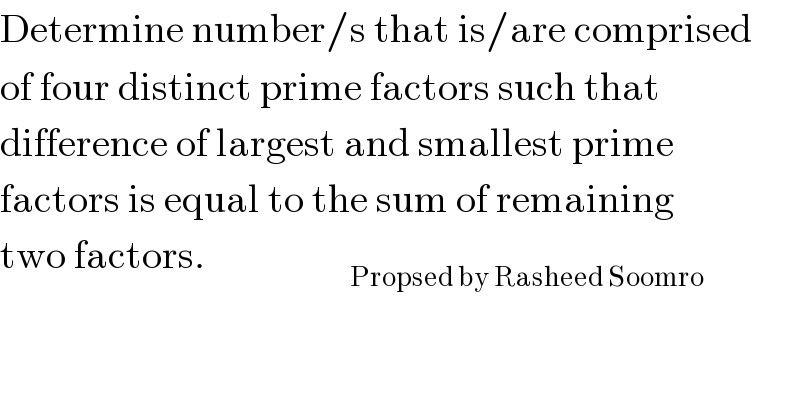
$$\mathrm{Determine}\:\mathrm{number}/\mathrm{s}\:\mathrm{that}\:\mathrm{is}/\mathrm{are}\:\mathrm{comprised} \\ $$$$\mathrm{of}\:\mathrm{four}\:\mathrm{distinct}\:\mathrm{prime}\:\mathrm{factors}\:\mathrm{such}\:\mathrm{that} \\ $$$$\mathrm{difference}\:\mathrm{of}\:\mathrm{largest}\:\mathrm{and}\:\mathrm{smallest}\:\mathrm{prime} \\ $$$$\mathrm{factors}\:\mathrm{is}\:\mathrm{equal}\:\mathrm{to}\:\mathrm{the}\:\mathrm{sum}\:\mathrm{of}\:\mathrm{remaining} \\ $$$$\mathrm{two}\:\mathrm{factors}.\:\:\:\:\:\:\:\:\:\:\:\:\:\:\:\:\:\:_{\mathrm{Propsed}\:\mathrm{by}\:\mathrm{Rasheed}\:\mathrm{Soomro}} \\ $$
Commented by FilupSmith last updated on 15/Nov/16
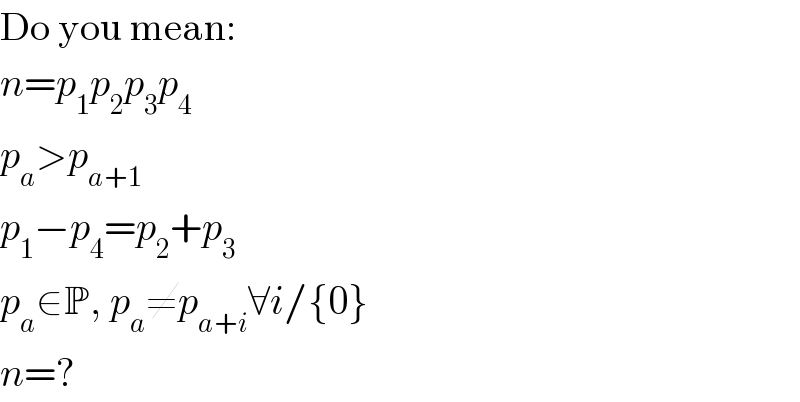
$$\mathrm{Do}\:\mathrm{you}\:\mathrm{mean}: \\ $$$${n}={p}_{\mathrm{1}} {p}_{\mathrm{2}} {p}_{\mathrm{3}} {p}_{\mathrm{4}} \\ $$$${p}_{{a}} >{p}_{{a}+\mathrm{1}} \\ $$$${p}_{\mathrm{1}} −{p}_{\mathrm{4}} ={p}_{\mathrm{2}} +{p}_{\mathrm{3}} \\ $$$${p}_{{a}} \in\mathbb{P},\:{p}_{{a}} \neq{p}_{{a}+{i}} \forall{i}/\left\{\mathrm{0}\right\} \\ $$$${n}=? \\ $$
Commented by Rasheed Soomro last updated on 16/Nov/16

$$\mathrm{Yes}\:\mathrm{Filup}\:\mathrm{I}\:\mathrm{mean}\:\mathrm{that}. \\ $$
Commented by FilupSmith last updated on 16/Nov/16
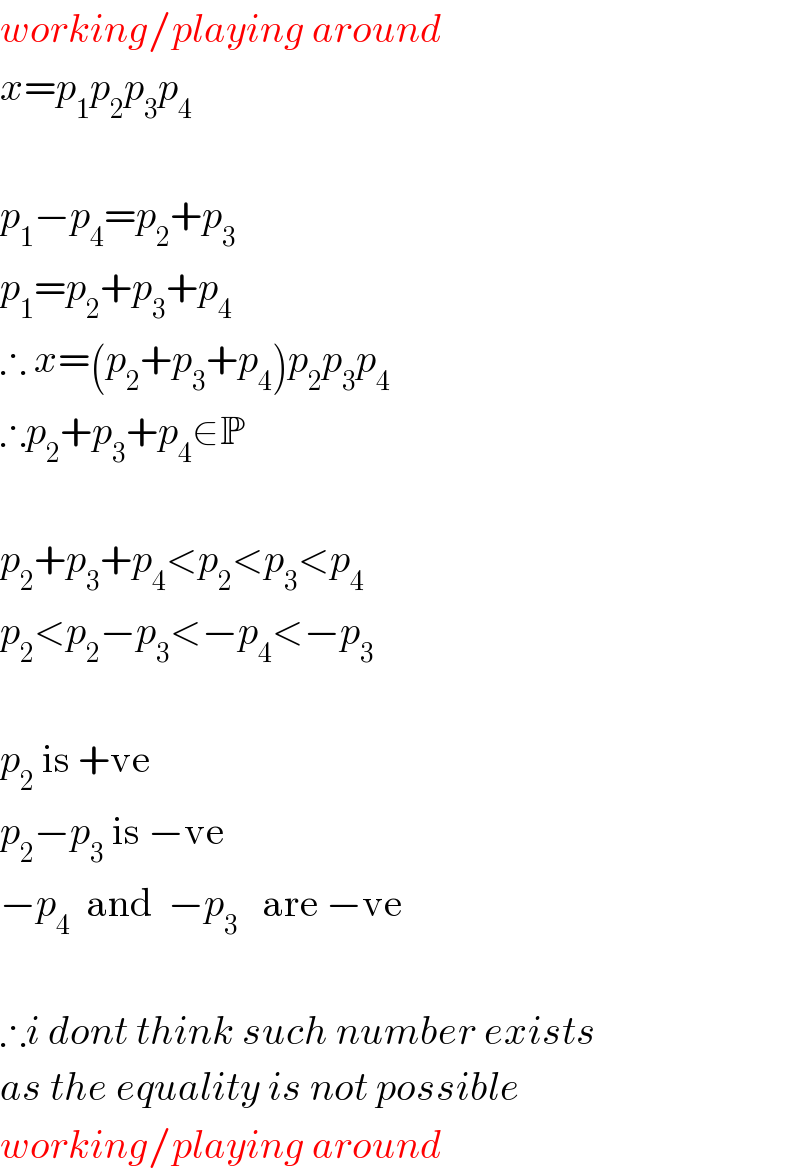
$${working}/{playing}\:{around} \\ $$$${x}={p}_{\mathrm{1}} {p}_{\mathrm{2}} {p}_{\mathrm{3}} {p}_{\mathrm{4}} \\ $$$$\: \\ $$$${p}_{\mathrm{1}} −{p}_{\mathrm{4}} ={p}_{\mathrm{2}} +{p}_{\mathrm{3}} \\ $$$${p}_{\mathrm{1}} ={p}_{\mathrm{2}} +{p}_{\mathrm{3}} +{p}_{\mathrm{4}} \\ $$$$\therefore\:{x}=\left({p}_{\mathrm{2}} +{p}_{\mathrm{3}} +{p}_{\mathrm{4}} \right){p}_{\mathrm{2}} {p}_{\mathrm{3}} {p}_{\mathrm{4}} \\ $$$$\therefore{p}_{\mathrm{2}} +{p}_{\mathrm{3}} +{p}_{\mathrm{4}} \in\mathbb{P} \\ $$$$ \\ $$$${p}_{\mathrm{2}} +{p}_{\mathrm{3}} +{p}_{\mathrm{4}} <{p}_{\mathrm{2}} <{p}_{\mathrm{3}} <{p}_{\mathrm{4}} \\ $$$${p}_{\mathrm{2}} <{p}_{\mathrm{2}} −{p}_{\mathrm{3}} <−{p}_{\mathrm{4}} <−{p}_{\mathrm{3}} \\ $$$$\: \\ $$$${p}_{\mathrm{2}} \:\mathrm{is}\:+\mathrm{ve} \\ $$$${p}_{\mathrm{2}} −{p}_{\mathrm{3}} \:\mathrm{is}\:−\mathrm{ve} \\ $$$$−{p}_{\mathrm{4}} \:\:\mathrm{and}\:\:−{p}_{\mathrm{3}} \:\:\:\mathrm{are}\:−\mathrm{ve} \\ $$$$\: \\ $$$$\therefore{i}\:{dont}\:{think}\:{such}\:{number}\:{exists} \\ $$$${as}\:{the}\:{equality}\:{is}\:{not}\:{possible} \\ $$$${working}/{playing}\:{around} \\ $$
Commented by mrW last updated on 16/Nov/16
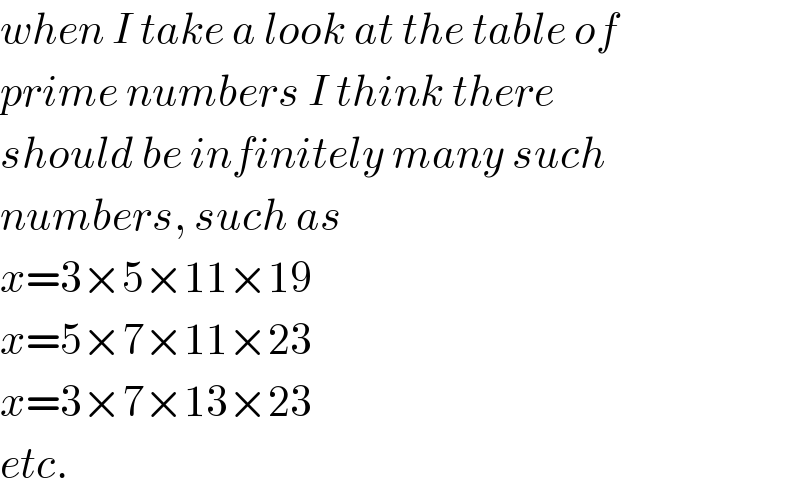
$${when}\:{I}\:{take}\:{a}\:{look}\:{at}\:{the}\:{table}\:{of}\: \\ $$$${prime}\:{numbers}\:{I}\:{think}\:{there} \\ $$$${should}\:{be}\:{infinitely}\:{many}\:{such} \\ $$$${numbers},\:{such}\:{as} \\ $$$${x}=\mathrm{3}×\mathrm{5}×\mathrm{11}×\mathrm{19} \\ $$$${x}=\mathrm{5}×\mathrm{7}×\mathrm{11}×\mathrm{23} \\ $$$${x}=\mathrm{3}×\mathrm{7}×\mathrm{13}×\mathrm{23} \\ $$$${etc}. \\ $$
Commented by Rasheed Soomro last updated on 16/Nov/16
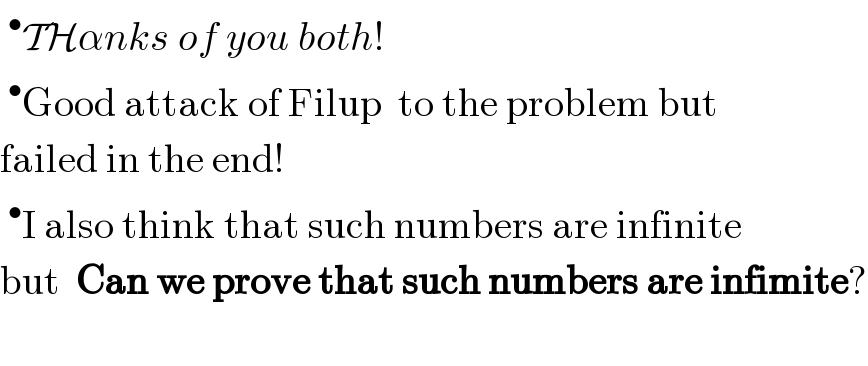
$$\:^{\bullet} \mathcal{TH}\alpha{nks}\:{of}\:{you}\:{both}! \\ $$$$\:^{\bullet} \mathrm{Good}\:\mathrm{attack}\:\mathrm{of}\:\mathrm{Filup}\:\:\mathrm{to}\:\mathrm{the}\:\mathrm{problem}\:\mathrm{but} \\ $$$$\mathrm{failed}\:\mathrm{in}\:\mathrm{the}\:\mathrm{end}! \\ $$$$\:^{\bullet} \mathrm{I}\:\mathrm{also}\:\mathrm{think}\:\mathrm{that}\:\mathrm{such}\:\mathrm{numbers}\:\mathrm{are}\:\mathrm{infinite} \\ $$$$\mathrm{but}\:\:\boldsymbol{\mathrm{Can}}\:\boldsymbol{\mathrm{we}}\:\boldsymbol{\mathrm{prove}}\:\boldsymbol{\mathrm{that}}\:\boldsymbol{\mathrm{such}}\:\boldsymbol{\mathrm{numbers}}\:\boldsymbol{\mathrm{are}}\:\boldsymbol{\mathrm{infimite}}? \\ $$$$ \\ $$
Commented by FilupSmith last updated on 16/Nov/16

$$\mathrm{I}\:\mathrm{wonder}\:\mathrm{where}\:\mathrm{I}\:\mathrm{went}\:\mathrm{wrong} \\ $$
Commented by FilupSmith last updated on 16/Nov/16
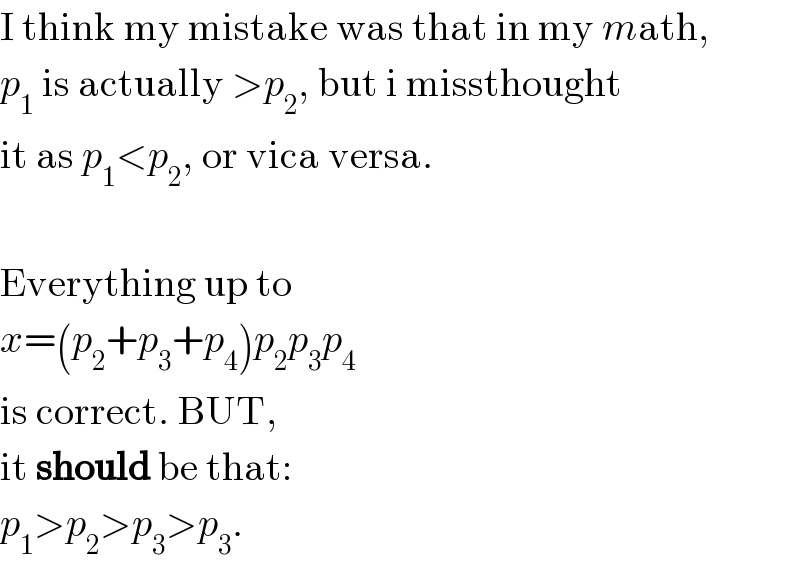
$$\mathrm{I}\:\mathrm{think}\:\mathrm{my}\:\mathrm{mistake}\:\mathrm{was}\:\mathrm{that}\:\mathrm{in}\:\mathrm{my}\:{m}\mathrm{ath}, \\ $$$${p}_{\mathrm{1}} \:\mathrm{is}\:\mathrm{actually}\:>{p}_{\mathrm{2}} ,\:\mathrm{but}\:\mathrm{i}\:\mathrm{missthought} \\ $$$$\mathrm{it}\:\mathrm{as}\:{p}_{\mathrm{1}} <{p}_{\mathrm{2}} ,\:\mathrm{or}\:\mathrm{vica}\:\mathrm{versa}. \\ $$$$\: \\ $$$$\mathrm{Everything}\:\mathrm{up}\:\mathrm{to} \\ $$$${x}=\left({p}_{\mathrm{2}} +{p}_{\mathrm{3}} +{p}_{\mathrm{4}} \right){p}_{\mathrm{2}} {p}_{\mathrm{3}} {p}_{\mathrm{4}} \\ $$$$\mathrm{is}\:\mathrm{correct}.\:\mathrm{BUT}, \\ $$$$\mathrm{it}\:\boldsymbol{\mathrm{should}}\:\mathrm{be}\:\mathrm{that}: \\ $$$${p}_{\mathrm{1}} >{p}_{\mathrm{2}} >{p}_{\mathrm{3}} >{p}_{\mathrm{3}} . \\ $$
